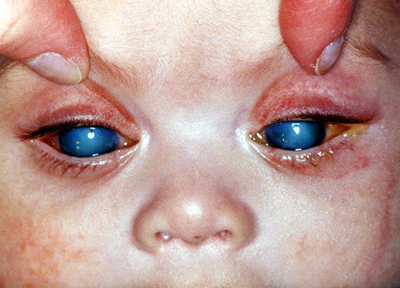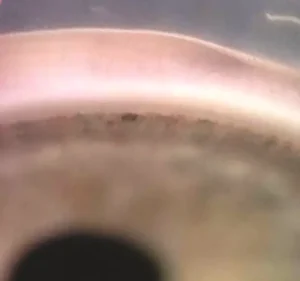What is glaucoma?
Glaucoma is a disease of the optic nerve, which transmits the images you see from the eye to the brain. The optic nerve is made up of many nerve fibers (like an electric cable with its numerous wires). Glaucoma damages these nerve fibers, which can cause blind spots and vision loss. When the condition is present at birth or develops in early childhood, it is referred to as congenital glaucoma.

Glaucoma develops when the pressure inside the eye, or intraocular pressure (IOP), is elevated. When the aqueous humor (the clear liquid that normally flows in and out of the eye) cannot drain properly, pressure builds up in the eye. The resulting increase in IOP can damage the optic nerve.
What causes congenital glaucoma?
Congenital glaucoma can be inherited and is also associated with several conditions and diseases, including neurofibromatosis, congenital rubella, Lowe’s syndrome, Sturge-Weber syndrome, homocystinuria, Marfan’s syndrome, Weill-Marchesani syndrome, Axenfeld- Rieger syndrome, Peter’s anomaly, aniridia, persistent hyperplastic primary vitreous (PHPV), nanophthalmos (small eye), and microcornea (small cornea).
Symptoms and signs of congenital glaucoma

Symptoms of congenital glaucoma include an enlarged eye, cloudy cornea, photophobia, tearing, and lid spasms. It may be necessary for the ophthalmologist (Eye M.D.) to perform an examination under anesthesia to examine the eyes and measure the intraocular pressure accurately. There is also a hallmark appearance to the angle in congenital glaucoma, including a posterior insertion of the iris and malformed trabecular meshwork, and Haab’s Striae from breaks in Descemet’s membrane of the cornea. If glaucoma is diagnosed, the ophthalmologist may recommend several surgical procedures to help reduce IOP and prevent damage to the child’s vision.
© 2025, 2015 Dr. Robert Schertzer Inc, based on 2007 The American Academy of Ophthalmology
